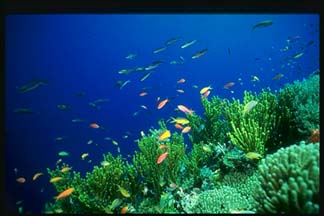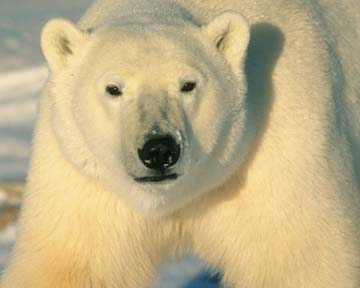This animation show where and when photosynthesis happens around the world as the seasons come and go. The land in the Northern Hemisphere gets greener each spring and summer, an indication of high rates of photosynthesis, and yellow during autumn as most plants become dormant and the amount of photosynthesis decreases. In tropical rainforest areas, plants live and photosynthesize all year long.
SeaWiFS Project
The Earth's Biosphere
The biosphere is all life on our planet. This includes all the things that are living as well as the remains of those that have died but have not yet decomposed. The biosphere includes life on land and in the oceans - multitudes of plants, animals, fungi, protists, and bacteria.
Have you heard the expression “carbon-based life forms”? The living things on our planet are called carbon-based because most of the molecules in them are chains of carbon atoms linked together. These carbon chains really add up when you consider the total amount of life on the planet. Add it all up and the life on our planet contains approximately 1900 gigatons of carbon. That’s heavier than 116 billion school buses!
The biosphere has a great impact on the climate because the biosphere is closely connected to the atmosphere. When plants harness the Sun’s energy through photosynthesis, oxygen is released into the atmosphere and carbon dioxide is taken out. When plants and animals respire, carbon dioxide gas is added to the atmosphere and oxygen is taken out. Microbes living in soils can add nitrous oxide gas to the atmosphere. As humans burn components of the biosphere such as fossil fuels, forests and fields, greenhouse gases such as carbon dioxide and nitrous oxide are released into the atmosphere.
Last modified May 7, 2007 by Lisa Gardiner.
You might also be interested in:

Kingdom Plantae contains almost 300,000 different species of plants. It is not the largest kingdom, but it is a very important one! In the process known as "photosynthesis", plants use the energy of the
...more
Members of the Kingdom Protista are the simplest of the eukaryotes. Protists are an unusual group of organisms that were put together because they don't really seem to belong to any other group. Some protists
...more
Eubacteria, also know as “true bacteria”, are microscopic prokaryotic cells. Cyanobacteria, also called blue-green algae, are Eubacteria that have been living on our planet for over 3 billion years. Blue-green
...more
Photosynthesis is the name of the process by which autotrophs (self-feeders) convert water, carbon dioxide, and solar energy into sugars and oxygen. It is a complex chemical process by which plants and
...more
Respiration is the name of the general process where organisms convert sugars and oxygen into biochemical energy. The process happens in all organisms, including animals, plants, fungi, and bacteria.
...more
Carbon dioxide (CO2) is a kind of gas. There isn't that much carbon dioxide in Earth's atmosphere, but it is still very important. Carbon dioxide is a greenhouse gas. That means it helps trap heat coming
...more
Look up into the sky and you look through millions of air molecules, eighty percent of which are nitrogen molecules, two atoms of nitrogen bonded together. Nitrogen is found all over the planet, not just
...more














